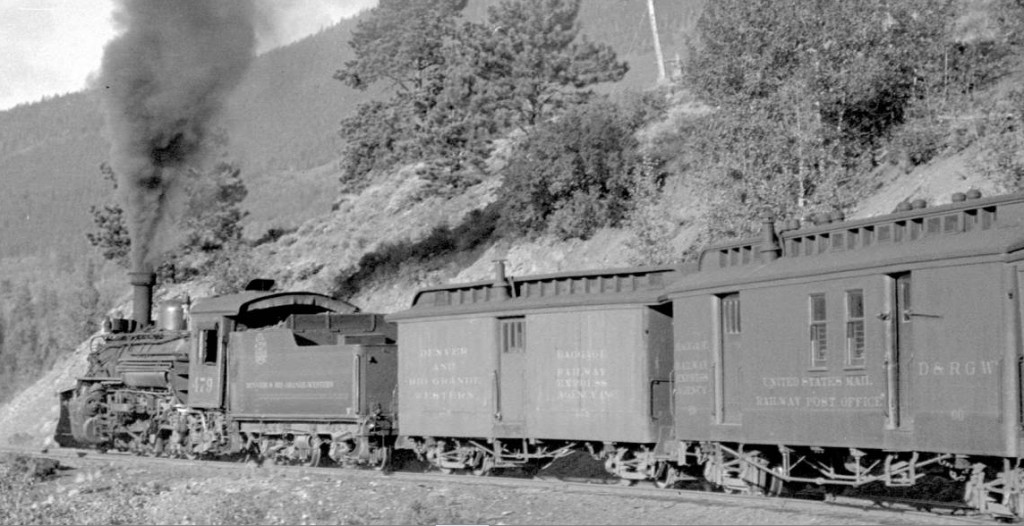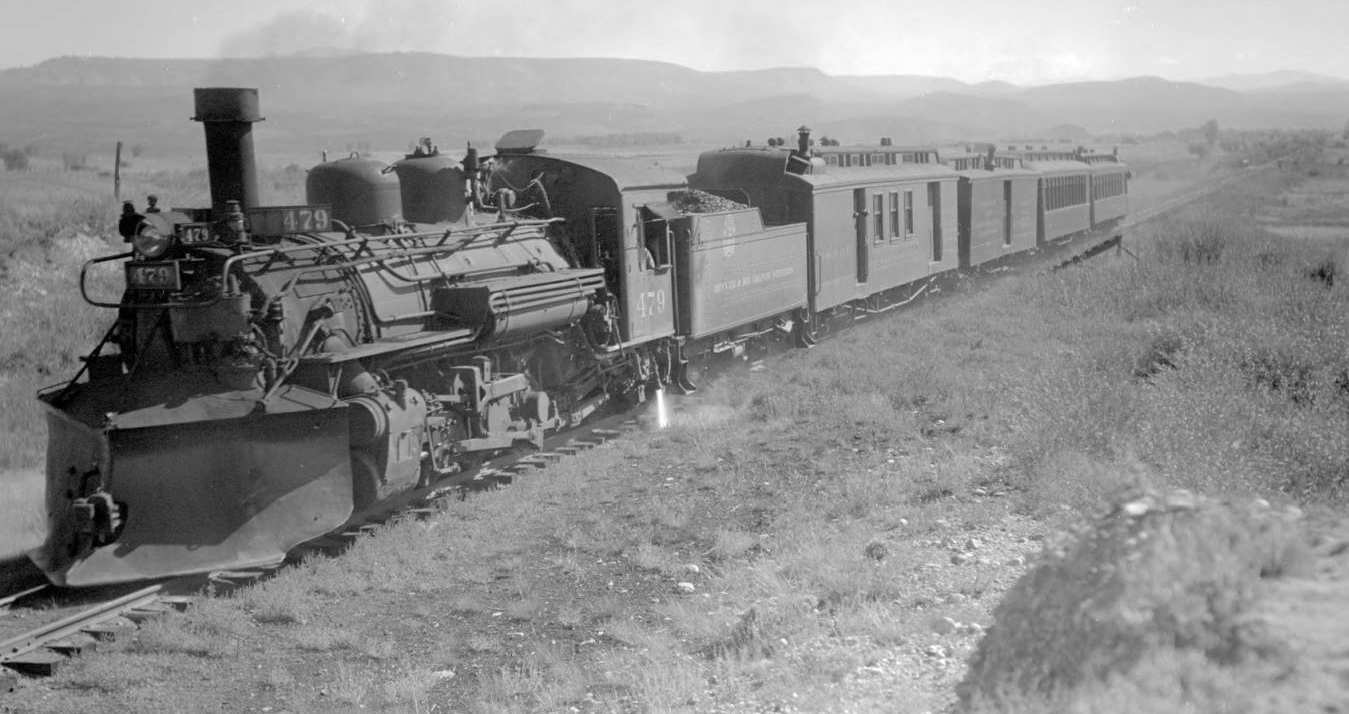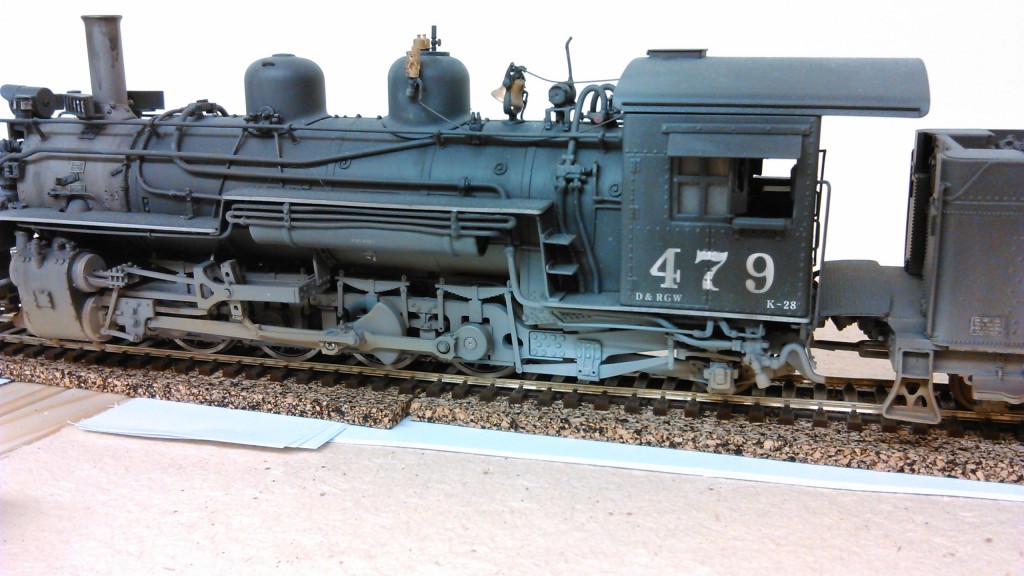D&RGW 479 was scrapped in 1946 after use on the White Pass and Yukon Railway in Alaska. WP&Y 256 (479), shipped back to Ogden, Utah, but refused by D&RGW, scrapped 1945 (boiler shipped to Pueblo, Colo., but never used)

D&RGW 479 Climbing Marshall Pass above Mears Junction, Colorado, September 5, 1936. Source: Denver Public Library
Purchased by the U.S. Army in 1942 for use on the White Pass. Retired and shipped out of Skagway, Alaska in 1944. Scrapped in 1946.
FEBRUARY 8, 1943 – Rotary No.1 with Engines 71 and 10 , accompanied by engine 256 was called out of Shops at 5:30 AM. Departed Shops at 7:30 AM, arriving Glacier at 9:50 AM. Engine 256, headed south, was coupled to rotary fleet out of Glacier. At Mile Post 16.5 draw bar was broken in baggage car 203 and engine 256 brought car back to Glacier. Rotary returned to Glacier for water at 1:10 PM and departed Glacier going north at 1:55 PM. Working their way through drifts from 6 to 16 feet deep they made favorable progress to the American Shed where two car lengths of drift was encountered inside the shed. Rotary was stalled at this point and, while endeavoring to back away, broke casting in draw bar of engine 71 and pulled out draw-head of rotary. They were successful in patching up rotary and moving it back to a point about 500 feet north of Bridge 19 A. Engine 10 ran out of water and fire was killed and engine drained. Engine 71 and the rotary were kept alive by shoveling snow in the tank but it finally became necessary to kill engine 71 account of shortage of coal.
Engine 62 rerailed at Fraser Loop switch at 4:15 PM. Both engines 81 and 62 were out of coal and it was necessary to use ties to keep engines alive. Had to shovel out snow from the north Fraser Loop switch back to Fraser ( ½ mile) in order to get engines and rotary back to Fraser for coal and water. This required all night February 8th and the early morning of February 9th.
Engine 256 returning to Glacier with coach after pulling out draw bar, stalled in snow at mile post 16.5 where engine was kept alive for some time by shoveling snow into the tank but it finally became necessary to kill engine and drain her.
Summing the situation to date, we have one rotary at Fraser without sufficient coal to move forward and snowed in back of rotary so that we were unable to return to Log Cabin or Bennett for coal; one rotary 500 feet south of the American Shed alive with draw bar out of south end; engines 10 and 71 dead at north end of steel bridge; engine 256 dead at milepost 16.5.

Train #315, The Shavano; 4 cars, 25 MPH. Photographed: near Gunnison, Colo., September 20, 1936. Denver Public Library
During World War II in 1942, the US Army demanded to requisition all 10 D&RGW K-28 for use on the White Pass & Yukon Railroad (WP&YR), a narrow gauge railroad linking southeast Alaska and Yukon Territory in Canada. The army took over the operation of the WP&YR itself, as it was a vital feeder to supply construction equipment to build the Alaska Highway, a route of strategic importance for the defense of Alaska. The Rio Grande managed to keep three K-28, but the other seven (#470, 471, 472, 474, 475, 477 and 479) were transferred to Alaska and renumbered USA 250 to 256 (but they would never be included in the WP&YR roster). They were subjected to a hard service with little maintenance, were put through a lot of strain by the very harsh winters of 1943 and 1944 and were worn out by the end of the war. They were taken back to Seattle, Washington in 1945, where they were scrapped on location in 1946, except for #472, brought to Seattle for repairs in 1944, and then transferred to Ogden, Utah where it was eventually scrapped as well in 1946. The three K-28 remaining on the Rio Grande (#473, 476 and 478) continued to be used on the San Juan during and after the war until the train was discontinued. Later during the fifties, they replaced the retiring K-27 on the Durango – Silverton branch. They were at first used on the single weekly mixed train, and then became the emblematic locomotives of the Silverton when tourism business developped and the number of trains increased in the sixties and seventies. In 1981, the D&RGW sold the three K-28 to the Durango & Silverton Narrow Gauge Railroad, the new operator of the line.
| Number Series |
Type | D&RGW Class |
Qty. | Date Delivered |
Notes |
| D&RGW 340-349 | 2-8-0 | C-19 | 10 | Built in 1881; renumbered from 400 series in 1924, which is likely when they received green boilers (if they received green boilers) | |
| D&RGW 450-464 | 2-8-2 | K-27 | 15 | 1903 | There may have been at least four K-27 class locomotives that wore green when delivered |
| D&RGW 470-479 | 2-8-2 | K-28 | 10 | 1923 | All 10 received green boilers in the early 1930s |
| D&RGW 480-489 | 2-8-2 | K-36 | 10 | 1925 | Unknown number received green boilers; most evidence shows that, other than 489, few if any had green boilers |
| D&RGW 490-495 | 2-8-2 | K-37 | 6 | 1928 | Unknown number received green boilers |
| D&RGW 496-499 | 2-8-2 | K-37 | 4 | 1930 | Unknown number received green boilers; 497 is documented as having a green boiler in 1928 |

